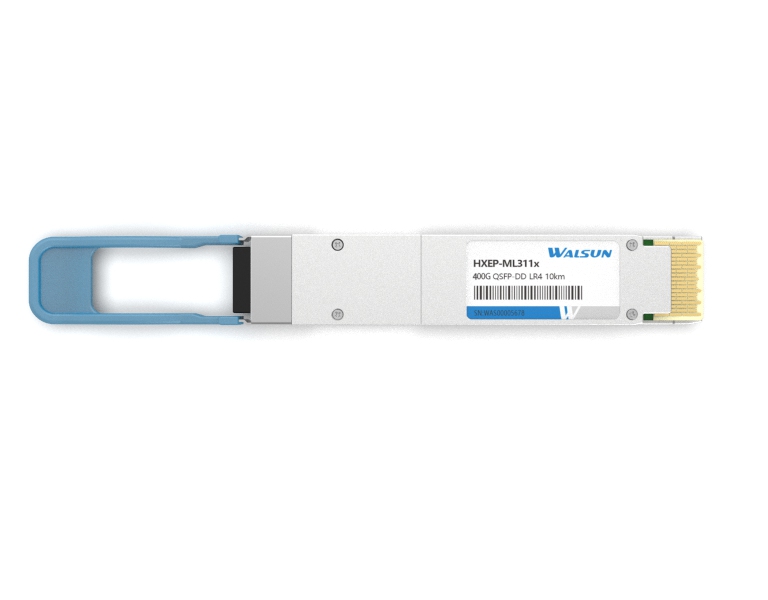

 Knowledge Base +
Knowledge Base +  2023.11.29
2023.11.29QSFP-DD (Quad Small Form Factor Pluggable Double Density) is a transceiver module used in high-speed data communication applications, such as data centers and high-performance computing networks. It is designed to support data rates of up to 400 Gbps.

The QSFP-DD module works by transmitting and receiving data over multiple lanes or, typically using parallel fiber optic cables. It supports up to 8 lanes of high-speed electrical or optical signals, which can be aggregated to achieve the desired data rate.
The QSFP-DD module also incorporates advanced signal processing and error correction techniques to ensure reliable and high-quality data transmission. It is hot-pluggable, meaning it can be inserted or removed from a compatible port without interrupting the operation of the system.
Overall, QSFP-DD modules are designed to provide high-speed, high-density, and reliable data communication in modern networking environments.
Bandwidth
QSFP-DD has up to ten times the bandwidth of QSFP+ or four times the bandwidth of QSFP28.
QSFP has four electrical channels at 10Gb/s (QSFP+) or 25Gb/s (QSFP28) per channel, with aggregation providing solutions at 40Gb/s or 100Gb/s. QSFP-DD's pluggable package electrical connector employs eight channels at up to 25Gb/s (NRZ modulation) or 50Gb/s (PAM4 modulation) per channel, with aggregation providing up to 200Gb/s (PAM4 modulation). The aggregation provides solutions up to 200Gb/s or 400Gb/s.
Compatibility
QSFP-DD is backward compatible with QSFP+/QSFP28. Systems designed with QSFP-DD modules are backward compatible and support existing QSFP+/QSFP28 modules, providing flexibility for end users and system designers.
Port Density
QSFP-DD and QSFP+/QSFP28 systems have the same port density. However, the QSFP-DD doubles the number of ASIC outlets supported by existing outlets such as the CAUI-4 because each QSFP-DD outlet can accommodate eight channels instead of four.
The mechanical connector of QSFP-DD on the motherboard is slightly deeper than that of QSFP+/QSFP28 to accommodate an additional row of contacts.
QSFP-DD is 10x/4x higher bandwidth than QSFP+/QSFP28 with only a small increase in length compared to QSFP+/QSFP28 while maintaining the same port density, and is also backward compatible, which means that it does not matter if the customer skips the QSFP and deploys the QSFP-DD system directly, reducing the cost of the equipment considerably.
OSFP is a new pluggable package with 8 high-speed electrical channels that will initially support 400Gb/s (8x50G).
Size
OSFP is more than twice the size of QSFP-DD.
Compatibility
OSFP is backward compatible with QSFP+/QSFP28, as is QSFP-DD, but requires the use of an additional OSFP-to-QSFP adapter.
Bandwidth
QSFP-DD currently supports up to 400Gb/s, but OSFPs can support up to 800Gb/s. QSFP-DD is mainly designed for the use of QSFP+/QSFP28, but requires the use of an additional OSFP-to-QSFP adapter.
While QSFP-DD is mainly for 400G networks that are about to be deployed on a large scale (and 200G for 100G to 400G overlay), OSFPs are more likely to be for 800G networks in the future. Therefore, in light of the current situation, QSFP-DD is a more appropriate package for 400G optical modules.
The CFP series started with CFP, then CFP2, then CFP4, and finally CFP8.
Size
CFP8 is significantly larger than QSFP-DD, and is more than three times the size of QSFP-DD.
(QSFP-DD VS CFP8 (The CFP series of optical modules has been positioned for carrier-grade applications, where the density requirements are not as high as those for data centers).
Compatibility
None of the CFP series appear to be backward compatible. CFP to QSFP28 and CFP2 to QSFP28 adapters have been available for CFP and CFP2 series optical modules for a long time.
Bandwidth
Both CFP8 and QSFP-DD have a maximum bandwidth of 400Gb/s, but CFP8 only supports 400Gb/s (16x25G or 8x50G), while QSFP-DD supports both 200Gb/s (8x25G) and 400Gb/s (8x50G).
Q&A
1、What is 400G QSFP-DD optical module?
A:400G optical module refers to the optical module products whose transmission rate reaches 400Gbps. Currently the mainstream packaging type is QSFP-DD and OSFP, QSFP-DD is a high-speed optical module interface specification, the upgraded version of the QSFP interface, support for 400G high-speed transmission. Using optical fiber as the signal transmission medium, by converting electrical signals into optical signals and transmitting them in the optical fiber.
2、What are the common types of 400G QSFP-DD optical modules in the market?
A: The common 400G QSFP-DD optical modules in the market have the following types in the market: QSFP-DD SR8, QSFP-DD DR4, QSFP-DD FR4, QSFP-DD FR8, QSFP-DD LR4, QSFP-DD LR8 and QSFP-DD ER8 optical modules.
3、What is the difference between QSFP-DD and OSFP optical modules?
A: QSFP-DD is smaller in size and more suitable for data center applications, which is the mainstream development direction, while OSFP is slightly larger in package size and consumes more power, which is more suitable for telecom applications. In contrast, the QSFP-DD interface provides four-channel small size and double the port density, OSFP for eight high-speed electrical channels, the current point of view of the QSFP-DD good compatibility and perfect support for 400G is still the preferred choice of the market.
4、What is the transmission distance of 400G QSFP-DD optical module?
A: The transmission distance of 400G QSFP-DD module depends on the type of fiber used and the specifications of the module. Generally speaking, it can support a transmission distance of 100m-40km.
5、What are the application scenarios of Walsun 400G QSFP-DD optical modules?
A: 400G QSFP-DD optical modules are usually used in high-bandwidth requirement scenarios such as internal connection in data centers, interconnection of data centers, and connection between network devices.
Subscribe to the newsletter
for all the latest updates.
2-5# Building, Tongfuyu Industrial Zone, Aiqun Road, Shiyan Street, Baoan District, Shenzhen. China
